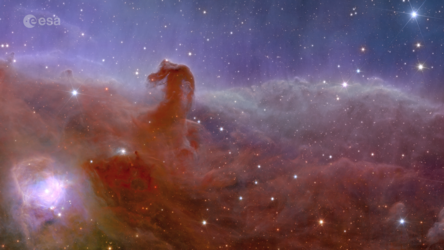Euclid’s view of the Horsehead Nebula
Euclid shows us a spectacularly panoramic and detailed view of the Horsehead Nebula, also known as Barnard 33 and part of the constellation Orion.
At approximately 1375 light-years away, the Horsehead – visible as a dark cloud shaped like a horse’s head – is the closest giant star-forming region to Earth. It sits just to the south of star Alnitak, the easternmost of Orion’s famous three-star belt, and is part of the vast Orion molecular cloud.
Many other telescopes have taken images of the Horsehead Nebula, but none of them are able to create such a sharp and wide view as Euclid can with just one observation. Euclid captured this image of the Horsehead in about one hour, which showcases the mission's ability to very quickly image an unprecedented area of the sky in high detail.
Read more about Euclid’s view of the Horsehead Nebula
Explore this image at the highest resolution in ESASky
Read more about Euclid's first images
[Technical details: The data in this image were taken in just about one hour of observation. This colour image was obtained by combining VIS data and NISP photometry in Y and H bands; its size is 8800 x 8800 pixels. VIS and NISP enable observing astronomical sources in four different wavelength ranges. Aesthetics choices led to the selection of three out of these four bands to be cast onto the traditional Red-Green-Blue colour channels used to represent images on our digital screens (RGB). The blue, green, red channels capture the Universe seen by Euclid around the wavelength 0.7, 1.1, and 1.7 micron respectively. This gives Euclid a distinctive colour palette: hot stars have a white-blue hue, excited hydrogen gas appears in the blue channel, and regions rich in dust and molecular gas have a clear red hue. Distant redshifted background galaxies appear very red. In the image, the stars have six prominent spikes due to how light interacts with the optical system of the telescope in the process of diffraction. Another signature of Euclid special optics is the presence of a few, very faint and small round regions of a fuzzy blue colour. These are normal artefacts of complex optical systems, so-called ‘optical ghost’; easily identifiable during data analysis, they do not cause any problem for the science goals. ]
[Image description: This square astronomical image is divided horizontally by a waving line between a white-orange cloudscape forming a nebula along the bottom portion and a comparatively blue-purple-pink upper portion. From the nebula in the bottom half of the image, an orange cloud shaped like a horsehead sticks out. In the bottom left of the image, a white round glow is visible. The clouds from the bottom half of the image shine purple/blue light into the upper half. The top of the image shows the black expanse of space. Speckled across both portions is a starfield, showing stars of varying sizes and colours. Blue stars are younger and red stars are older.]




